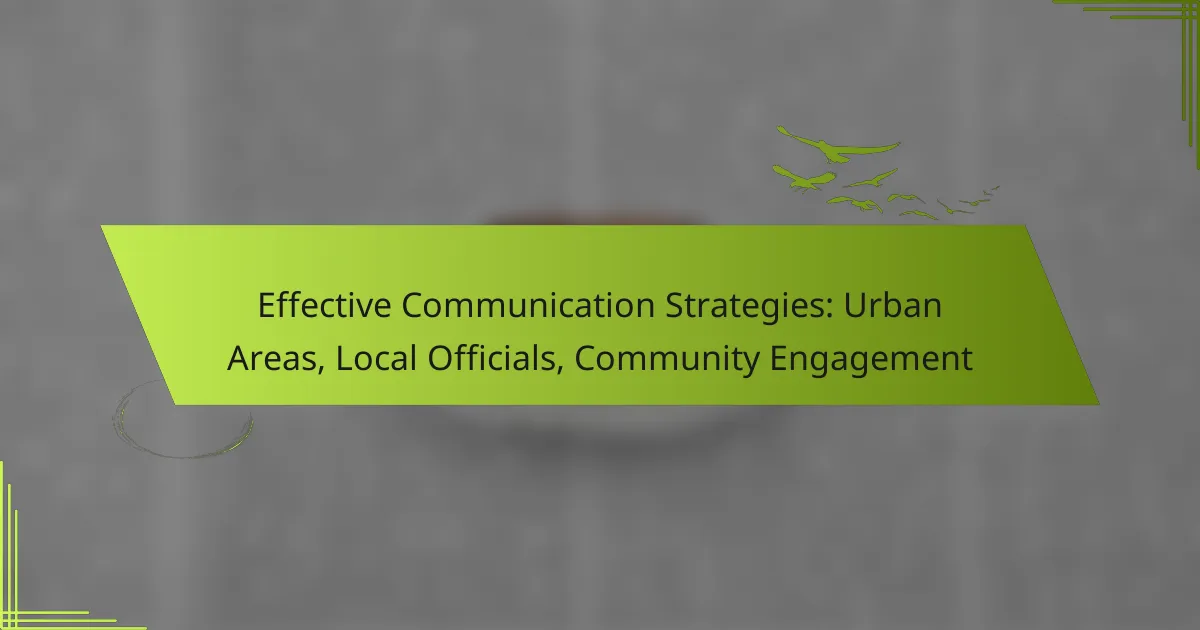Effective communication strategies are essential for urban officials to engage their communities and promote transparency. By utilizing various channels such as town hall meetings and interactive online platforms, local officials can foster collaboration and build trust with residents. Embracing technology further enhances these efforts, enabling real-time engagement and streamlined information sharing between citizens and their government.
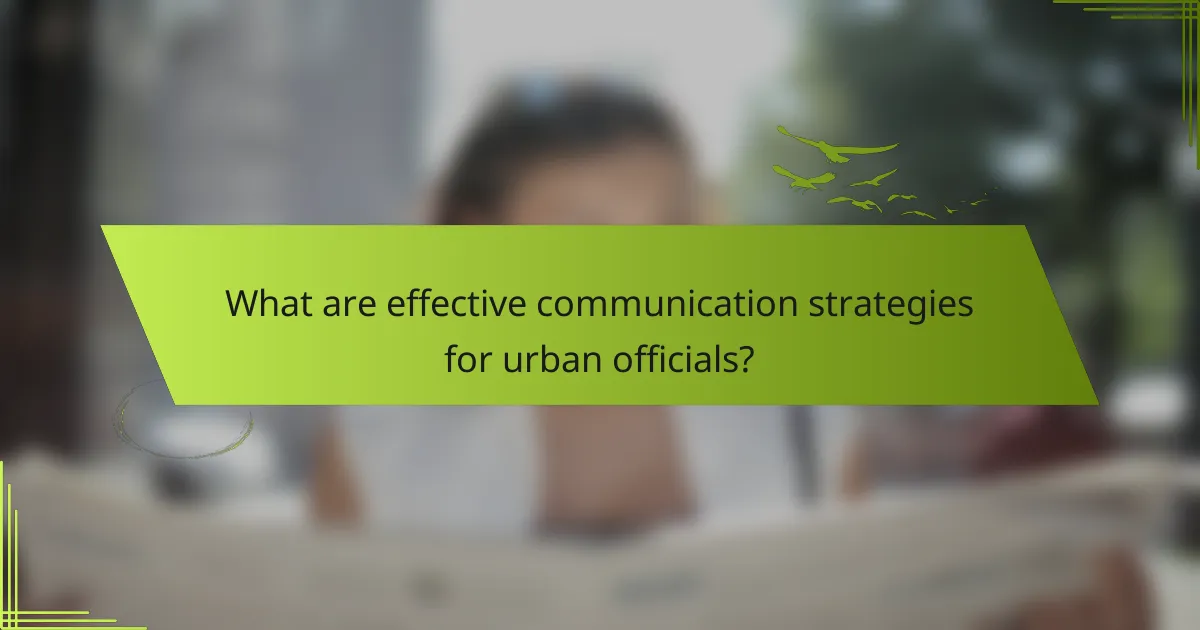
What are effective communication strategies for urban officials?
Effective communication strategies for urban officials involve engaging the community through various channels to ensure transparency and foster collaboration. These strategies help build trust, gather feedback, and enhance public participation in local governance.
Community forums
Community forums are organized gatherings where urban officials can present information and engage directly with residents. These events allow for open dialogue, enabling officials to address concerns and gather input on local issues. To maximize participation, schedule forums at convenient times and promote them through multiple channels.
Consider holding forums in accessible locations, such as community centers or parks, to encourage diverse attendance. Providing refreshments and child care can also enhance turnout and create a welcoming atmosphere.
Social media engagement
Social media engagement is a powerful tool for urban officials to connect with residents quickly and effectively. Platforms like Facebook, Twitter, and Instagram allow for real-time updates, announcements, and community interaction. Regularly posting content and responding to comments can foster a sense of community and keep residents informed.
To optimize social media use, officials should create a content calendar and utilize visuals to capture attention. Engaging in conversations and addressing concerns promptly can enhance trust and demonstrate responsiveness to community needs.
Public surveys
Public surveys are an essential method for gathering feedback from residents about local issues and initiatives. These surveys can be distributed online or in print, allowing officials to collect data on community preferences and priorities. Aim for concise surveys to encourage participation and ensure clarity in questions.
Consider offering incentives, such as gift cards or local business discounts, to increase response rates. Analyzing survey results can provide valuable insights that inform decision-making and policy development.
Collaborative workshops
Collaborative workshops bring together residents, stakeholders, and urban officials to brainstorm solutions to community challenges. These interactive sessions encourage participation and creativity, allowing diverse perspectives to shape local initiatives. Workshops should be structured to facilitate discussion and problem-solving.
Utilizing facilitators can help guide conversations and ensure that all voices are heard. Follow up with participants after the workshop to share outcomes and next steps, reinforcing the value of their contributions.
Neighborhood newsletters
Neighborhood newsletters serve as a direct communication channel between urban officials and residents, providing updates on local events, initiatives, and important information. These newsletters can be distributed digitally or in print, depending on community preferences. Consistency in delivery is key to maintaining engagement.
Include sections for community highlights, upcoming meetings, and ways residents can get involved. Encouraging feedback through the newsletter can also help officials gauge community interests and concerns, fostering a two-way communication flow.
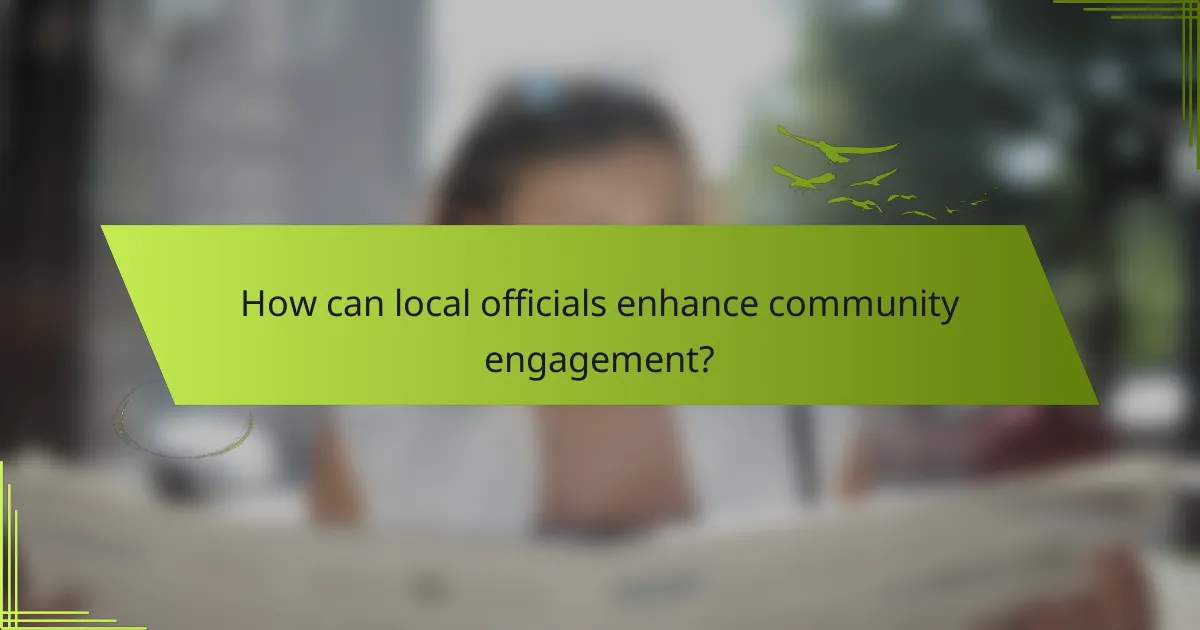
How can local officials enhance community engagement?
Local officials can enhance community engagement by implementing strategies that foster open communication and collaboration with residents. Effective methods include regular town hall meetings, partnerships with local organizations, interactive online platforms, and robust feedback mechanisms.
Regular town hall meetings
Regular town hall meetings provide a platform for local officials to connect directly with community members. These gatherings allow residents to voice their concerns, ask questions, and receive updates on local initiatives. Scheduling these meetings at convenient times and locations can significantly increase participation.
To maximize engagement, consider varying the formats of these meetings, such as in-person discussions, virtual options, or hybrid models. Providing refreshments or incentives can also encourage attendance and create a welcoming atmosphere.
Partnerships with local organizations
Forming partnerships with local organizations can enhance community engagement by leveraging existing networks and resources. Collaborating with schools, nonprofits, and businesses allows officials to reach diverse groups and foster a sense of shared purpose.
For example, local governments can work with community centers to host events or workshops that address specific issues. This approach not only broadens outreach but also builds trust and strengthens community ties.
Interactive online platforms
Utilizing interactive online platforms can significantly improve communication between local officials and residents. Websites, social media, and mobile apps can facilitate real-time updates and discussions, making it easier for citizens to engage with their local government.
Officials should ensure these platforms are user-friendly and accessible, providing clear information and opportunities for feedback. Regularly updating content and responding to inquiries promptly can help maintain community interest and involvement.
Feedback mechanisms
Implementing effective feedback mechanisms is crucial for understanding community needs and preferences. Surveys, suggestion boxes, and public forums can gather valuable insights from residents, allowing officials to make informed decisions that reflect the community’s priorities.
It’s important to communicate how feedback will be used and to follow up with residents on the outcomes of their input. This transparency fosters trust and encourages ongoing participation in the engagement process.
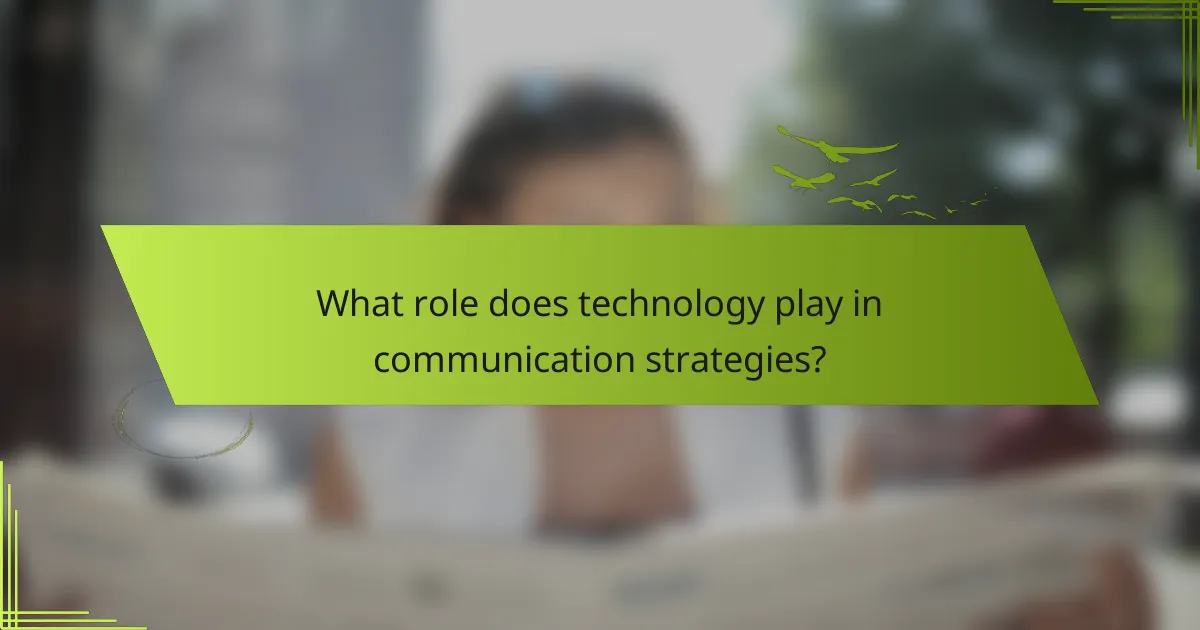
What role does technology play in communication strategies?
Technology serves as a vital tool in enhancing communication strategies for local officials and urban communities. It facilitates real-time engagement, streamlines information sharing, and fosters transparency between citizens and their government.
Mobile apps for citizen reporting
Mobile apps empower citizens to report issues such as potholes, streetlight outages, or public safety concerns directly to local officials. These platforms often allow for photo uploads and GPS tagging, making it easier for authorities to address problems efficiently.
For effective implementation, municipalities should ensure the app is user-friendly and widely promoted. Regular updates and feedback mechanisms can enhance user engagement and trust in the system.
Virtual town halls
Virtual town halls provide a platform for local officials to engage with residents in real-time, regardless of location. These online meetings can increase participation by accommodating those who may have difficulty attending in-person events.
To maximize effectiveness, officials should promote these events through multiple channels, including social media and community newsletters. Ensuring accessibility features, such as closed captioning, can also broaden participation.
Data analytics for community needs
Data analytics allows local officials to assess community needs by analyzing trends and feedback from various sources, including surveys and social media. This information can guide decision-making and resource allocation to better serve residents.
Officials should prioritize data privacy and transparency when collecting and analyzing community data. Regularly sharing insights with the public can build trust and encourage further community engagement.
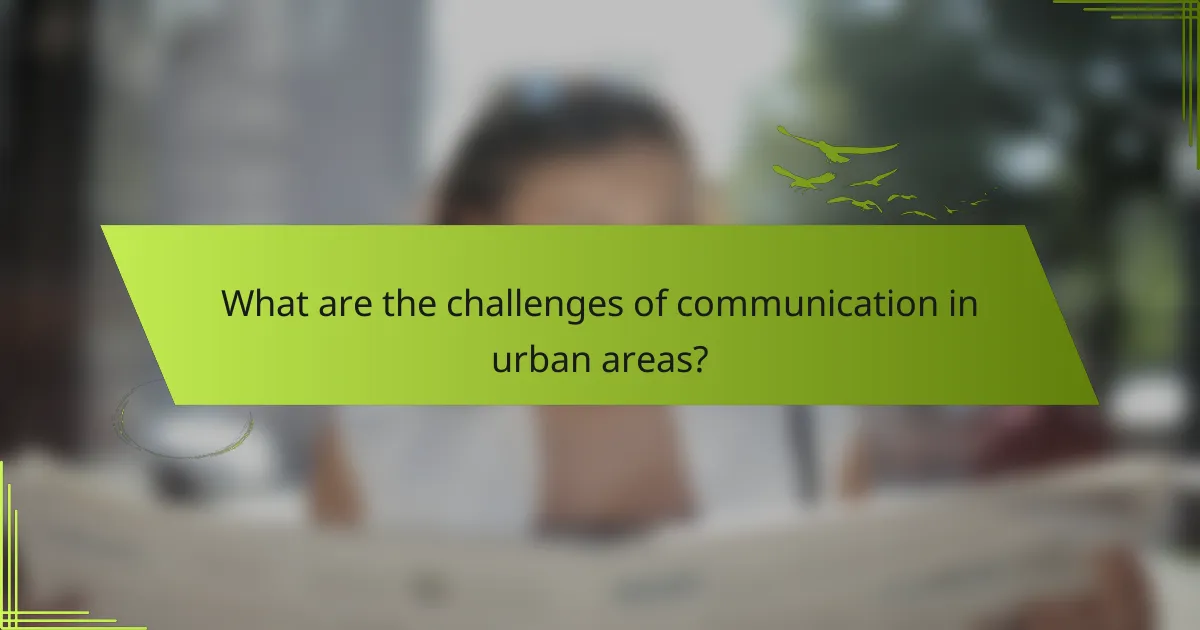
What are the challenges of communication in urban areas?
Communication in urban areas faces several challenges due to the complexity and diversity of the environment. Factors such as varied population needs, information overload, and language barriers significantly impact effective engagement between local officials and community members.
Diverse population needs
Urban areas often host a wide range of demographics, each with unique needs and preferences. Local officials must recognize that different groups may prioritize various issues, such as housing, transportation, or public safety. Tailoring communication strategies to address these diverse interests is essential for fostering community engagement.
To effectively reach different segments, officials can segment their audience based on factors like age, socioeconomic status, or cultural background. Utilizing targeted messaging through appropriate channels—such as social media for younger populations or community meetings for older residents—can enhance outreach efforts.
Information overload
Urban residents are frequently bombarded with information from multiple sources, including social media, news outlets, and community bulletins. This saturation can lead to confusion and disengagement, making it difficult for important messages to stand out. Local officials must strive to simplify their communications to cut through the noise.
To manage information overload, officials should prioritize clarity and brevity in their messages. Using bullet points, infographics, and concise language can help convey essential information quickly. Regularly updating communication channels with relevant content ensures that residents remain informed without feeling overwhelmed.
Language barriers
Language diversity in urban areas can hinder effective communication between local officials and residents. Many community members may not speak the dominant language fluently, which can lead to misunderstandings and exclusion from important discussions. Addressing language barriers is crucial for inclusive engagement.
Officials can implement translation services, bilingual materials, and community workshops to bridge the gap. Collaborating with local organizations that serve non-English speakers can also enhance outreach efforts. Ensuring that key information is available in multiple languages fosters a more inclusive environment and encourages broader participation in community initiatives.
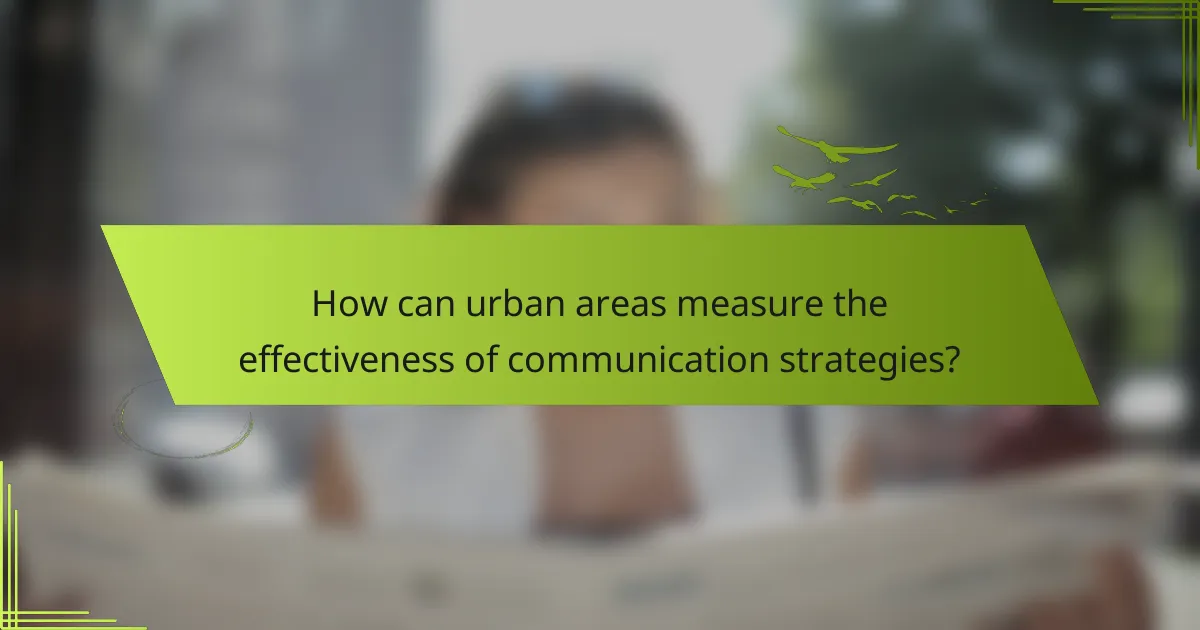
How can urban areas measure the effectiveness of communication strategies?
Urban areas can measure the effectiveness of communication strategies through various metrics, including community feedback, engagement levels, and the clarity of information disseminated. By analyzing these factors, local officials can assess how well their messages resonate with residents and adjust their approaches accordingly.
Community Surveys and Feedback
Conducting community surveys is a direct method for urban areas to gauge the effectiveness of their communication strategies. Surveys can include questions about residents’ understanding of local initiatives, satisfaction with information received, and preferred communication channels. Regularly collecting feedback helps officials identify areas needing improvement.
In addition to surveys, feedback can be gathered through town hall meetings or online forums. These platforms allow residents to voice their opinions and provide insights into how communication can be enhanced. Engaging with the community in this way fosters trust and encourages more open dialogue.
Engagement Metrics
Engagement metrics, such as social media interactions, website traffic, and attendance at community events, are crucial for measuring communication effectiveness. High engagement levels often indicate that messages are resonating with the audience. For instance, tracking likes, shares, and comments on social media posts can reveal which topics are most relevant to residents.
Local officials should establish benchmarks for these metrics to assess progress over time. Comparing current engagement levels with past data can help identify trends and inform future communication strategies. Regular analysis ensures that officials remain responsive to community needs.
Clarity and Accessibility of Information
The clarity and accessibility of information are vital components of effective communication. Urban areas should ensure that messages are straightforward, avoiding jargon and technical language that may confuse residents. Using clear visuals, such as infographics or charts, can enhance understanding.
Additionally, providing information in multiple languages and formats can help reach diverse populations within urban areas. This inclusivity ensures that all community members have access to important information, thereby improving overall engagement and participation.
